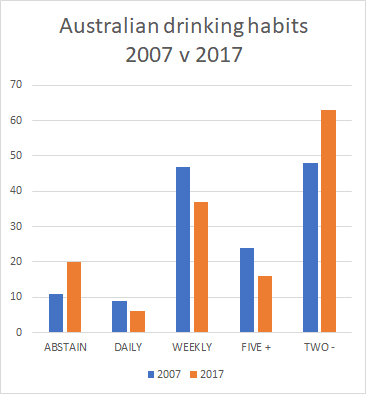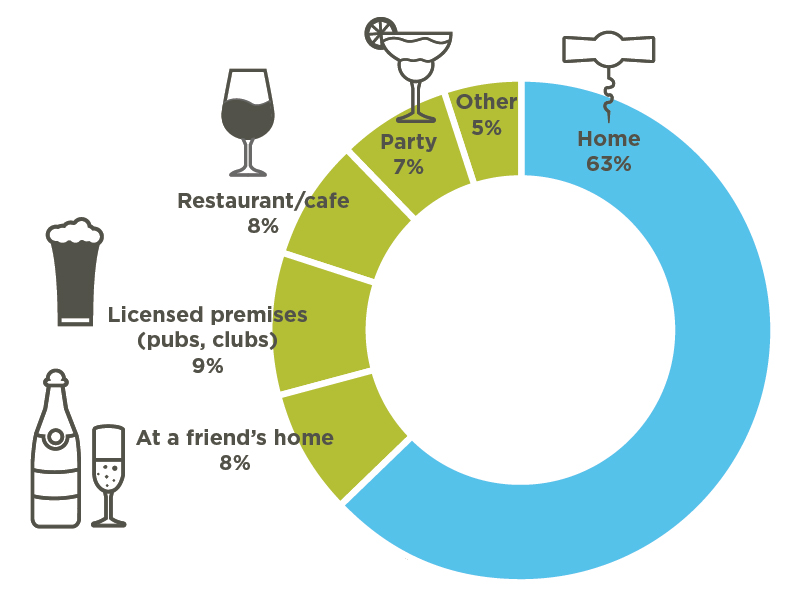New research out of Drinkwise and Nielsen gives insight into the changing ways Australian social sectors are consuming alcohol.
Drinkwise’s Australian Drinking Habits 2007 vs 2017 is a comprehensive study comparing survey results a decade apart, providing a view on the changes to all aspects of drinking behaviour, including people’s frequency, quantity, type, reason for and place of drinking.
Broadly speaking, Australians are drinking more moderately, and rates of excessive and underage drinking are decreasing. The decline in consumption is associated strongly with concerns over personal health, lifestyle factors and a preference for moderation.
 “Generally speaking, Australians are interested in leading a healthy lifestyle; issues including weight management and getting enough exercise are of higher concern to most Australians than their drinking,” says DrinkWise ambassador Dr Andrew Rochford.
“Generally speaking, Australians are interested in leading a healthy lifestyle; issues including weight management and getting enough exercise are of higher concern to most Australians than their drinking,” says DrinkWise ambassador Dr Andrew Rochford.
However, drinking motivations, drink type and quality are also changing, providing some opportunity for in-tune venues to capture a greater share of the evolving marketplace.
Enhancing and celebrating social occasion, winding down and taste were all cited as primary motivators for consuming alcohol, while financial concerns in the shape of housing affordability and unemployment were found to be the greatest life concerns for Australians. Alcohol abuse came in 21st on this list, even behind the gap between rich and poor and political integrity.
These opposing factors offer opportunity for licensed premises positioning themselves as local meeting places, particularly those focusing on a value proposition for patrons.
In terms of what people are drinking, low-alcohol nearly doubled its share (from four to seven per cent) as moderation and transport continue to influence choice of potency. RTDs have dropped dramatically in popularity (from ten to four per cent), as the applied tax rate continues to make mixed drinks made to order a better deal.
While the vast majority of alcohol is still consumed in the home, the former staple cask wine continues to flag (down from nine to five per cent) as Australians continue to choose quality and variety over price.
And the newcomer to the market, cider – not even measured in 2007 – now represents eight per cent of beverage sales, making it a must on any drinks menu.
Also of pertinence to venues, there is a widening in the perception that Australia has a problem with alcohol, those in agreeance increasing from 70 to 73 per cent, those disagreeing dropping from 25 to 20 per cent.

Furthermore, the belief that there should be stricter enforcement and penalties for alcohol-related poor behaviour has followed suit, those in agreeance increasing from 75 to 78 per cent, those disagreeing dropping from 22 to 16 per cent.
The Consumer & Media View research by Nielsen also looked at the habits and choices of Australian drinkers, offering particular insight into the nature of the next generation, those currently aged 18 to around 30.
The Nielsen data found that just 53 per cent of ‘Millenials’ (Gen Y, born since 1990) had consumed alcohol in the past month, as compared with 65 per cent of Gen X (born 1970 or later) and 72 per cent of Boomers (pre-1970).
But Millennials aren’t necessarily spending less than other groups on their socialising, including drinking. The key motivators for this demographic focus on ‘newness’ and image, and many are willing to pay more for products that meet these criteria.
This can be seen in the fact that (amongst the drinkers) 55 per cent have consumed vodka, most likely in some form of cocktail, and 33 per cent have consumed cider, versus the 16 per cent average across the market. In the beer drinkers, 43 per cent like to try imported beer(s).
What’s more, 52 per cent of Millennials say they will visit a pub or bar in a typical week. The data show that when there, they will likely spend more than both Gen Xers or Boomers.
Unsurprisingly, 54 per cent cite they “cannot live” without their mobile phone, so charging options are a must.
And enviro-vandals beware, a noteworthy 62 per cent of this age group will purposefully avoid a product or business that provokes concerns over its impact on the environment.






